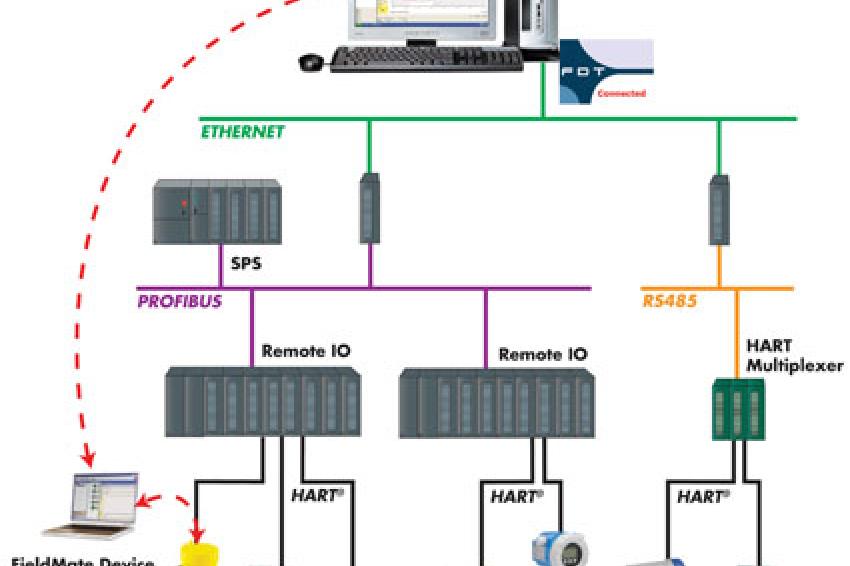Fit For The Future
Integrated FDT Solution Saves Time and Cost
The various components may use different communication protocols such as Hart, Profibus or Foundation Fieldbus, and are often based on different device integration technologies.
The situation is not different at Nedmag Industries Mining and Manufacturing. Based in Veendam in the Netherlands, Nedmag is the leading European supplier of very pure, synthetic dead burned magnesium oxide (DBM).
Three years ago, Nedmag had only a vision of modern asset management. Today, the company prides itself on its user-friendly plant asset management system providing central access to all instruments and offering users a perfect future-proof automation structure. With an integrated asset management system using FDT technology combined with a "multilingual" device management tool, Nedmag Industries achieves real productivity advantages and savings in its maintenance and service operations.
Improving Productivity
Using state-of-the-art automation technology will help any organisation to carry out its operations with fewer employees. This is a feature which is becoming increasingly important as the number of specialised personnel available to manufacturing companies is constantly decreasing. Furthermore, the external maintenance provider with which the manufacturing company is working must understand the technology and be able to use it, even if their own personnel regularly changes.
There are other areas where major savings can be made. Not only does the team save time on maintenance tasks if they can access a device directly from a PC: so too does the service provider. With its standardised and integrated interfaces, FDT technology provides a common environment for configuring, operating or maintaining any device - regardless of vendor, type or communication protocol.
The Dutch company was initially using a complex, non-Windows based system for plant asset management. Wim Zomer, project leader at Nedmag, recalls: "I always had to keep the instruction manual handy to know what to do next. We used the system so rarely that we always needed to remind ourselves how to use it the next time. Therefore, user-friendliness was high up on the list of priorities when the team went to search for a new system."
In Yokogawa's PRM (Plant Resource Manager), they found a system that completely satisfied their requirements. With FieldMate - Yokogawa's integrated device management tool - the vendor also provides a solution to portable device maintenance. Another important advantage of this package is that all device data can be accessed centrally thanks to the synchronisation between the two systems.
A further benefit of this solution is that it enables unlimited access to all intelligent field devices. FieldMate from Yokogawa was the first tool to fully embrace both the FDT and EDDL device integration technologies, and it supports all the important Fieldbus protocols in the process industries.
Device Patrol Saves Time
Earlier, it often took days of downtime before plant failures were fixed. In particular, the analog technology used often meant that engineers had to undertake a lengthy process of searching for and systematically ruling out possible causes of faults: a process that could last up to one or even two days. FDT technology, on the other hand, allows the user to look into the device directly from a PC. Central access means that incorrect parameters can be identified and a diagnosis given immediately. By using Hart Communication and end-to-end FDT technology, engineers at Nedmag can now resolve most issues much more quickly and efficiently than before. A look at the PC and the instrument tells what is wrong.
A key function of the PRM system is Device Patrol, which continuously monitors the status of all the devices in the system. In the past, if there was a problem with a level measurement, for example, the automation team had to ask the external service provider to take a look at the device. The maintenance engineer would then check on-site to see if a cable or input card, for example, was faulty. Now, by opening the plant asset management system, the engineer immediately can identify the errors at an instrument, even though the device might be kilometres away.
The mine, where the basic raw material magnesium chloride is extracted, is at a distance of 5 km from the production site and the offices. "If somebody has to travel there, it takes up to half a day to get into the car, drive to the other side of Veendam, arrive at reception, set up the laptop and carry out the tests. This is far too time-consuming." Now, as Wim Zomer explains: "At the PC, we usually know what to do within a short time. Even if somebody had been on-site, it would not have been possible to repair the instrument as it was simply configured incorrectly. Thanks to FDT technology, it is not necessary to send somebody to the plant, leading to savings in time and travel costs."
Nedmag still has high hopes of implementing features such as predictive maintenance in the future. This may not be too far off as all the necessary ingredients are in place. The Plant Resource Manager has only been running for a few months. The main focus in the initial stage was to save time on service and maintenance tasks. The more tasks the automation team can solve directly from the PC, the greater the savings the company can make.
Technology Offers Added Value
The automation experts also appreciate other system features, which make day-to-day work so much easier. For example, the audit trail enables detailed tracking of any changes to the device. Who did what, why and when? If a device issues a warning, the history shows the number of warnings and faults previously issued.
The Dutch company also reaped the benefits of FDT technology during the commissioning phase in the automation of the first of two sintering furnaces. The team was required to test a large number of instruments within a short time frame. The commissioning stage is simpler and faster if the plant asset management system can be used to test and simulate an instrument, and to check if it is "alive."
Fit for the Future
Wim Zomer explains: "If we do not include the time invested in developing the concept, then the digitalisation of 240 devices, which can be read online using FDT, cost a total of €15,000. Today, approximately two thirds of the devices are intelligent through HART communication. They will be gradually connected to the company's network in order to be able to take full advantage of the intelligence they contain. The number of devices that can be operated, monitored and maintained from a central point continues to grow.
"We can say today that we want to proceed with plant asset management, but it cannot be done overnight. Everything takes time. The main thing is to dare to take the first step," explains Wim Zomer with conviction. The technology works. Now it is time for the next generation to roll out these state-of-the-art solutions in all of the plants and to take advantage of the opportunities they offer. Nedmag can already report initial success in the area of device management and the time savings that have been gained here.
The first step has been taken. From the field to the office, the combination of digital communication and FDT technology offers users centralised access to each and every device at all levels. Nedmag is perfectly prepared for the future thanks to the FieldMate device management assistant and the Plant Resource Manager from Yokogawa.
Contact
Yokogawa Deutschland GmbH
Broichhofstr. 7-11
40880 Ratingen
Germany
+49 2102 4983 0
+49 2102 4983 22







